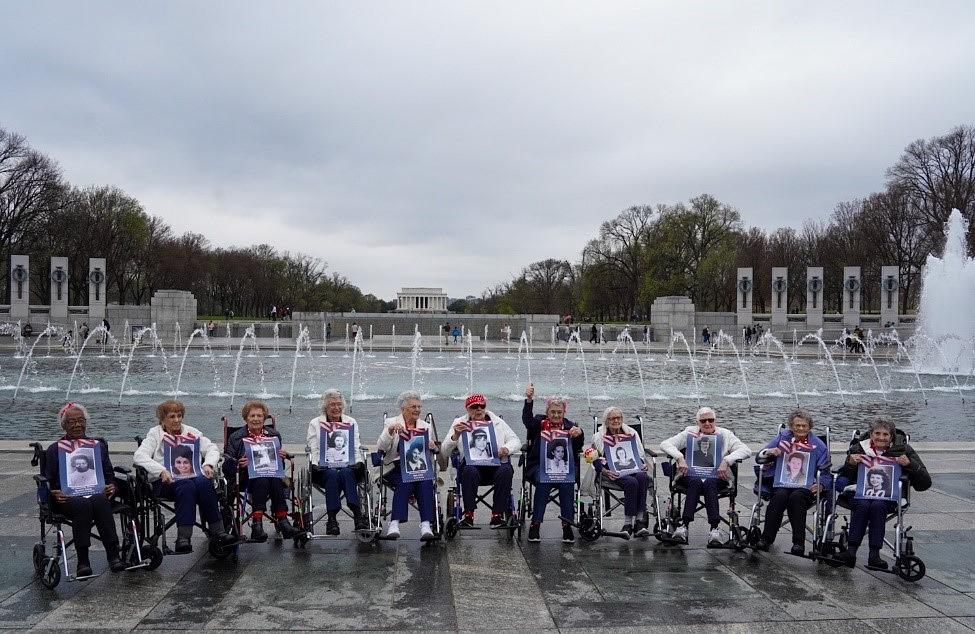Source: Boeing
- Boeing helps bring a group of “Rosies” to Washington, D.C., for a special celebration
An Honor Flight, similar to those for military veterans, brought a group of eleven “Rosie the Riveters” to the nation’s capital for a day of celebration on March 27. The flight was sponsored, in part, by Boeing and organized by the Eastern Michigan WOW Chapter of the American Rosie the Riveter Association and Honor Flight Network’s Michigan-based hub, Talons Out Honor Flight.
The group of eleven Rosies all wore the signature red polka-dot clothing that has become synonymous with Rosie the Riveter. (Boeing photo)“Rosies,” symbolized by the iconic “We can do it!” image, answered the call of duty during World War II, working in factories building bombers, tanks and other weapons — jobs traditionally done by men.
“Up until 1941, it was a man’s world. And they didn’t realize how capable women are,” said Mae Krier, who worked as a riveter for Boeing on the B-17 and B-29 lines in Seattle. Krier, like many of her fellow Rosies, left home at the age of 17 to find work to support the war effort.
The group toured the U.S. Capitol, including a stop to pose for a photo at the Portrait Monument, which honors the women who fought for suffrage—a powerful symbol of what the suffragists and the Rosies accomplished for the women who came after them.
“It’s up to a woman if she wants a career raising a family or be an astronaut. We have that choice now,” said Krier.
Mae Krier and the Rosies visited the World War II Memorial in Washington, D.C. (Boeing photo)The Rosies also visited the World War II Memorial, a reminder of why they headed to work after the U.S. entered the war.
“We were doing all that hard work in the factory so they could put their lives on the line. It was worth it to have them come back,” said Ruth Pegowski, a riveter who worked at a manufacturing plant outside Detroit that produced the B-24.
The Rosies pose with photos of themselves as young women. (Boeing photo)The day ended with a reception in honor of the Rosies at Boeing’s Arlington, Virginia, headquarters, where they were presented with Boeing heritage pins and Rosie the Riveter challenge coins.
“I travel a lot to speak with women and young girls and they always ask, ‘did you ever imagine what an icon Rosie the Riveter would become?’ I tell them we didn’t do it for honor or an award. We wanted to serve our country like the men fighting overseas,” said Krier.
Recently, Krier helped advocate for the Rosie the Riveter Congressional Gold Medal Act, which collectively awards a Congressional Gold Medal to the millions of women who helped build aircraft, motor vehicles, weapons and ammunition during WWII. During the pandemic, Krier sewed Rosie-themed red polka-dot face masks, one of which was flown aboard the Boeing CST-100 Starliner second Orbital Flight Test, or OFT-2.
Ziad Ojakli, Boeing executive vice president of Government Operations, presented Krier with these special, space-flown items during the reception.
Ziad Ojakli, executive vice president of Government Operations, presents Boeing retiree Mae Krier with the space-flown Rosie mask and bandana. (Boeing photo)“Mae, your legacy, and the legacy of all Rosies, live strong to this day. You continue to inspire women and young girls — even those young girls in the room today who will eventually blaze trails of their own — to pursue their dreams and break down barriers,” said Ojakli. “You are a shining example of this legacy, and we are grateful for all that you have done.”

